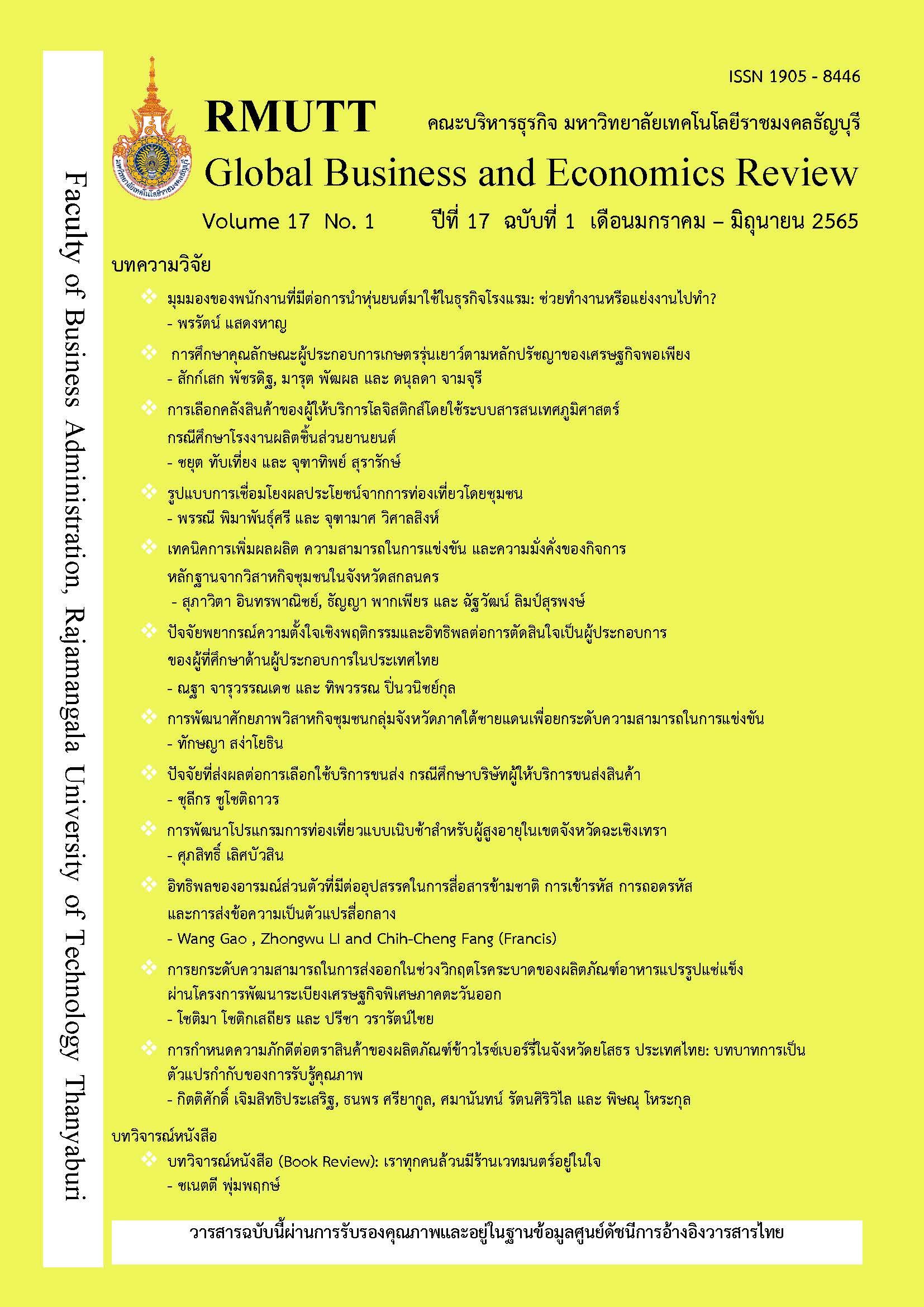EMPLOYEES’ PERSPECTIVE ON ROBOTIC ADOPTION IN THE HOTEL BUSINESSES: SUPPORT OR STEAL JOBS FROM HUMAN?
Keywords:
Acceptance of Robots, Human-Robot Collaboration, Service Robot, Hotel BusinessAbstract
This study aimed at investigating the stakeholders’ opinion toward robot adoption in the hotel businesses at the Eastern Economic Corridor (EEC). Mixed-methods research was conducted by employing a sequential exploratory strategy. Starting from a qualitative research method, thereafter, based on the findings from qualitative research, the survey questionnaire was drafted for using in the quantitative research method. Findings from the qualitative stage revealed that stakeholders in the hotel businesses at the EEC accepted the robot adoption. Factors involving in robot acceptance were human, robot, and organization. These three factors also related to the human-robot interaction. According to the survey, in quantitative findings, employees of hotels in the EEC accepted the robot at a moderate level. Regarding factors involving in robot acceptance, respondents agreed with robot factor at a high level, and agreed with organzizational factor and human factor at a moderate level. Respondents also agreed with human-robot collaboration at a high level.
References
Bagdasarov, Z., Martin, A. A., & Buckley, M. R. (2018). Working with robots: organizational consideration. Organizational Dynamics, 49(2), 1-8.
Bayne, K. M., & Parker, R. J. (2012). The introduction of robotics for New Zealand forestry operations: Forest sector employee perceptions and implications. Technology in Society, 34(2), 138-148.
Dahlin, E. (2019). Are robots stealing our jobs?. Sociological Research for a Dynamic World, 5, 1–14.
Decker, M., Fischer, M., & Ott, I. (2017, January). Service robotics and human labor: a first technology assessment of substitution and Cooperation. Robotics and Autonomous Systems, 87, 348-354.
Dietz, T., Pott, A., Hägele, M., & Verl, A. (2013, October) A new, uncertainty-aware cost-model for cost-benefit assessment of robot systems in IEEE ISR 2013 (pp. 1-6). Seoul, Korea (South): IEEE.
Dillman D. (2000). Mail and Internet surveys: The total design method (2nd ed.). New York: Wiley.
Hannola, L., Richter, A., Richter, S., & Stocker, A. (2018). Empowering production workers with digitally facilitated knowledge processes.
International Journal of Production Research, 56(2),1-15.
Holthaus, P., & Wachsmuth, S. (2021). It was a pleasure meeting you: Towards a holistic model of human–robot encounters. International Journal of Social Robotics, 13, 1729– 1745.
Hu, Y., Benallegue, M., Venture, G., & Yoshida, E. (2020). Interact with me: An exploratory study on interaction factors for active physical human-robot interaction. IEEE Robotics and Automation Letters, 99,1-1.
Ivanov, S. H., Webster, C., & Berezina, K. (2017). Adoption of robots and service automation by tourism and hospitality companies. Revista Turismo & Desenvolvimento, 27/28, 1501-1517.
Khaksar, S. M. S., Khosla, R., Chu, M. T., & Shahmehr, F. S. (2016). Service innovation using social robot to reduce social vulnerability among older people in residential care facilities. Technological Forecasting and Social Change, 113 Part B, 438-453.
Khosla, R., Nguyen, K., & Chu, M.T. (2014) Assistive robot enabled service architecture to support home-based dementia care in 2014 IEEE 7th International Conference on Service-Oriented Computing and Applications (pp. 73–80). Matsue, Japan: IEEE.
Li, D., Rau, P. L. P. & Li, Y. (2010). A cross-cultural study: Effect of robot appearance and task. International Journal of Social Robotics, 2, 175–186.
Lu, L., Cai, R., & Gursoy, D. (2019) Developing and validating a service robot integration willingness scale. International Journal of Hospitality Management, 80, 36–51.
McCartney, G. & McCartney, A. (2020). Rise of the machines: towards a conceptual service-robot research framework for the hospitality and tourism industry. International Journal of Contemporary Hospitality Management, 13(12), 3835-3851.
Moran, D. (2020). Introduction to phenomenology. London: Routledge.
Osawa, H., Ema, A., Hattori, H., Akiya, N., Kanzaki, N., Kubo, A., Koyama, T., & Ichise, R. (2017). Analysis of robot hotel: Reconstruction of works with robots. 26th IEEE International Symposium on Robot and Human Interactive Communication (RO-MAN), pp. 219-223.
Pan, Y., Okada, H., Uchiyama, T., & Susuki, K. (2015). On the reaction to robot’s speech in a hotel public space. International of Social Robotics, 7, 911-920.
Sung, J. Y., Christensen, H. I., & Grinter, R. E. (2009). Robots in the wild: understanding long-term use. 4th ACM/IEEE International Conference on Human-Robot Interaction (HRI), pp.45-52.
Turja, T. & Oksanen, A. (2019). Robot acceptance at work: a multilevel analysis based on 27 EU countries. International Journal of Social Robotics, 11, 679–689.
Weiss, A., Bernhaupt, R., Lankes, M., & Tscheligi, M. (2009). The USUS evaluation framework for human-robot interaction. 23rd Convention of the Society for the Study of Artificial Intelligence and Simulation of Behaviour, pp. 11-26.
Wirtz, J., Patterson, P. G., Kunz, W. H., Gruber, T., Lu, V. N., Paluch, S., & Martins, A. (2018). Brave new world: service robots in the frontline. Journal of Service Management, 29(5), 907–931.
Xu, S. T., Stienmetz, J., & Ashton, M. (2020). How will service robots redefine leadership in hotel management? a delphi approach. International Journal of Contemporary Hospitality Management, 32, 2217–2237.
Downloads
Published
How to Cite
Issue
Section
License
Copyright (c) 2022 พรรัตน์ แสดงหาญ

This work is licensed under a Creative Commons Attribution-NonCommercial-NoDerivatives 4.0 International License.
The articles published in this journal are the intellectual property of their respective authors.
The views and opinions expressed in each article are solely those of the individual authors and do not reflect the positions of Rajamangala University of Technology Thanyaburi or any of its faculty members. All components and content of each article are the sole responsibility of the respective authors. In the event of any errors, the authors shall bear full responsibility for their own work.








